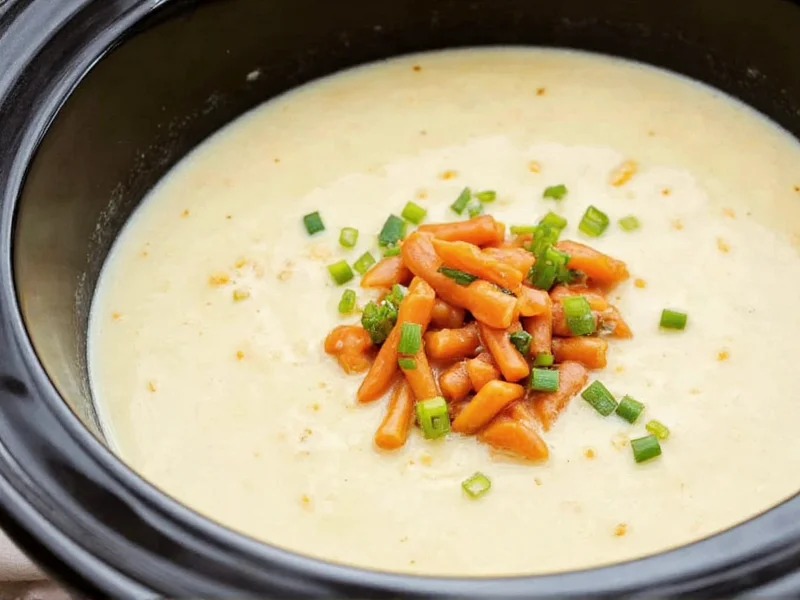Slow cooker cream of potato soup offers hands-off convenience while developing deep flavors, but requires specific techniques to handle dairy properly. Unlike stovetop methods where you can control heat precisely, slow cookers maintain consistent temperatures that can cause milk or cream to curdle if added too early. This guide provides a tested method that delivers velvety results every time, with professional tips you won't find in basic recipes.
The Science Behind Slow Cooker Cream Soups
Understanding temperature dynamics is crucial for successful cream-based soups in slow cookers. Most models maintain temperatures between 170-280°F (77-138°C), with the 'low' setting typically around 200°F (93°C) and 'high' near 300°F (149°C). Dairy products like milk and cream begin to curdle at 180°F (82°C), which falls within your slow cooker's operating range. This explains why adding dairy at the beginning often results in grainy, separated soup.
Professional chefs solve this by using one of two approaches: either adding dairy during the final hour of cooking, or creating a roux-based thickener that stabilizes the dairy. Our recommended cream of potato soup slow cooker method combines both techniques for foolproof results.
Essential Ingredients for Perfect Texture
The potato variety you choose significantly impacts your soup's final texture. Waxy potatoes like Yukon Gold maintain their structure better during long cooking times while still breaking down enough to create natural creaminess. Avoid starchy varieties like Russets which can become gluey.
For the dairy component, heavy cream provides the richest results, but you can substitute half-and-half for a lighter version. Never use skim milk as it lacks sufficient fat content to prevent curdling. For dairy-free cream of potato soup slow cooker options, full-fat coconut milk works surprisingly well when combined with a cornstarch slurry.
| Slow Cooker Setting | Vegetable Cooking Time | Dairy Addition Point | Total Time |
|---|---|---|---|
| Low | 3-4 hours | Last 45-60 minutes | 4-5 hours |
| High | 2-2.5 hours | Last 30-45 minutes | 2.5-3 hours |
| Programmable | 3 hours | Auto-switch to warm + add dairy | 3.5 hours |
Step-by-Step Slow Cooker Cream of Potato Soup Recipe
This professional-tested method ensures smooth, restaurant-quality results. The key cream of potato soup slow cooker technique is separating the vegetable cooking phase from the dairy integration phase.
Ingredients
- 2 lbs Yukon Gold potatoes, peeled and cubed
- 1 large yellow onion, diced
- 3 cloves garlic, minced
- 4 cups vegetable or chicken broth
- 2 sprigs fresh thyme
- 1 bay leaf
- 1 cup heavy cream (or full-fat coconut milk for dairy-free)
- 3 tbsp butter
- 3 tbsp flour
- Salt and white pepper to taste
- Optional: 4 oz cooked bacon, crumbled
Instructions
- Combine potatoes, onion, garlic, broth, thyme, and bay leaf in slow cooker. Cook on high for 2.5 hours or low for 4 hours until potatoes are fork-tender.
- Remove thyme sprigs and bay leaf. Use an immersion blender to puree soup until smooth (or carefully transfer to countertop blender).
- In a small saucepan, melt butter over medium heat. Whisk in flour to create a roux, cooking for 2 minutes until golden.
- Gradually whisk in 1 cup of the hot potato mixture to temper the roux, then return to slow cooker.
- Stir in heavy cream and cook on 'warm' setting for 30-45 minutes (do not return to high heat).
- Season with salt and white pepper. For dairy-free cream of potato soup slow cooker version, add coconut milk at this stage.
- Garnish with bacon, chives, or grated cheese before serving.
Troubleshooting Common Issues
Problem: Soup is too thin
Solution: Mix 1 tbsp cornstarch with 2 tbsp cold water, then stir into soup during the final 30 minutes. Avoid adding plain flour directly which can create lumps.
Problem: Dairy has curdled
Solution: Immediately remove from heat and blend with immersion blender. The mechanical action can sometimes rescue slightly curdled dairy. For future batches, add dairy later in the cooking process and ensure your slow cooker isn't set too high.
Problem: Flavor is bland
Solution: Enhance with 1 tsp onion powder, ½ tsp garlic powder, and a splash of white wine added during the final 30 minutes. The alcohol will cook off while leaving depth of flavor.
Variations for Dietary Needs
Dairy-Free Cream of Potato Soup Slow Cooker Method
Substitute heavy cream with full-fat coconut milk and replace butter with olive oil. Add 1 tbsp nutritional yeast for cheesy depth without dairy. The natural fats in coconut milk provide similar richness while the roux stabilizes the texture.
Loaded Baked Potato Version
After adding dairy, stir in ½ cup shredded cheddar cheese and 4 oz cooked, crumbled bacon. Top individual servings with additional cheese, bacon, and chives.
Herbed Potato Leek Soup
Replace half the potatoes with leeks (white and light green parts only). Add 1 tbsp fresh dill and 1 tsp fresh rosemary during the final 30 minutes for a more sophisticated flavor profile.
Storage and Reheating Guidelines
Cream-based soups present unique storage challenges. Always cool soup completely before refrigerating, and consume within 3 days for best quality. When reheating, use low heat on the stovetop and avoid boiling which can cause separation. For optimal results, add a splash of cream while reheating to refresh the texture.
Freezing dairy-based soups isn't recommended as the texture often becomes grainy upon thawing. If you must freeze, omit the dairy before freezing and add fresh cream when reheating. This dairy-free cream of potato soup slow cooker approach works better for freezing.











 浙公网安备
33010002000092号
浙公网安备
33010002000092号 浙B2-20120091-4
浙B2-20120091-4